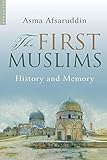The First Muslims History and Memory
Material type: TextPublication details: Oxford One World 2012Description: 253pISBN:
TextPublication details: Oxford One World 2012Description: 253pISBN: - 9781851684977
- SS80 AF880
| Item type | Current library | Call number | Status | Date due | Barcode | |
|---|---|---|---|---|---|---|
 Books
Books
|
DVK Library Stack -> Third Floor -> SS | SS80 AF880 (Browse shelf(Opens below)) | Available | 11049008 |
includes index and biblioraphy
The Rise of Islam and Life of the Prophet Muhammad i The Constitution of Medina 4 War and peace 7 The Treaty of al-Hudaybiyya i o The fall of Mecca 12 Farewell pilgrimage 13 Remembering the Prophet, the Beloved of God 16 The Issue of Succession to the Prophet 19 Early tension between kinship and individual moral excellence 2 2 Why did the Prophet not indicate a successor? 2 6 The Age of the Rightly-Guided Caliphs 27 Abu Bakr, the first caliph 2 7 `Umar ibn al-Khattab, the second caliph 3o The End of Rightly-Guided Leadership 47 Political administration 47 The collection of the Qur`an 48 Toward fragmentation of the community j o The caliphate of`Ali ibn AbiTahb 51 The first civil war j 2 The legacy of the era of the Rightly-Guided Caliphs 54 The Age of the Companions 59 Ibn `Abbas: the sage of the Muslim community 61 Ibn Mas` ud: interpreter of the Word of God 63 ` A` isha bint Abi Bakr: the beloved of Muhammad 6 6 Umm `Umara: valiant defender of the Prophet 70 Bilal ibn Rabah: the voice of Islam 71 Conclusion 7 3 The Age of the Successors 76 The historical milieu 76 The politics of piety and the second civil war 81 The third civil war 8 j The`Abbasid revolution 87 Prominent successors 90 The consolidation of Shi` i thought 9 j The rise of law and jurisprudence among the early Sunnis 98 The Successors to the Successors I: Administration Leadership, and Jihad 106 The founding of Baghdad i o 6 Statecraft, administration, and leadership: acquiring a Persian flavor 107 The concept of jihad: Qur`anic antecedents and the classica juridical doctrine 108 Reading the Qur`an in context 109 Later understandings of jihad 115 Negotiating the poly valence of the term jihad 116 Many paths to martyrdom 12 o Changes in conceptions of leadership 12 3 The Successors to the Successors II: Humanism, Law, and Mystical Spirituality 129 The rise of humanism 12 9 The flourishing of law and jurisprudence i 3 7 The rise of tasawwuf( ufism) 142 Constructing the Pious Forbears I: Historical Memory and the Present 148 The Islamist construction 148 Implications and relevance of studying the lives of the first Muslims today i j i The Salafal-Salih in the Islamist imagination 155 Constructing the Pious Forbears II: Historical Memory and the Present 16 8 The significance of the Salafal-Salih for the modernists 16 8 Assessment of Islamist and Modernist Views 18 3 The "Islamic State" 183 The pervasiveness of the religious law and its scope 18 7 Status of women 190 The nature of jihad 19 2
There are no comments on this title.
